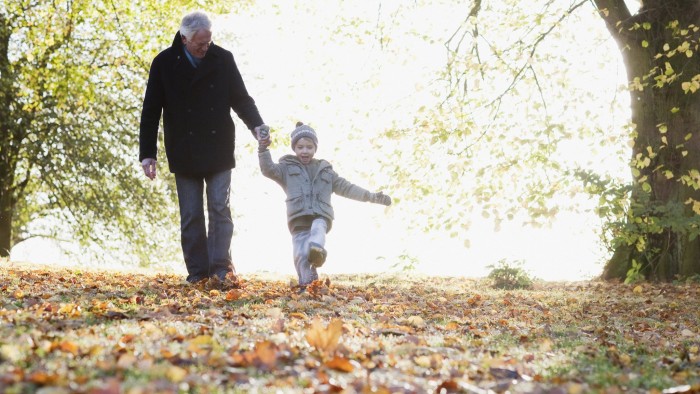How to invest for your grandchildren

Roula Khalaf, Editor of the FT, selects her favourite stories in this weekly newsletter.
Having been born shortly after the war, I am an early “baby-boomer”, the most financially fortunate of all recent generations.
We have enjoyed a benevolent welfare state, free higher education, a rise in the property market the likes of which are unlikely to be repeated on top of final salary pension schemes that can no longer be afforded.
What can we do to give the younger members of our families a better chance in later life than is presently on offer?
It is interesting to reflect upon the evolution of the family over the past three centuries. In the 19th century, we had parents and children; in the 20th century, we had grandparents, parents and children; and in the 21st century the norm is likely to be great-grandparents, grandparents, parents and children. Like the Royal family, nowadays it is common to find four generations alive at the same time.
Yet we still live by the mores of the 19th century with the expectation that parents should bequeath to their immediate children. But for families with four generations still living, inheritance tax (IHT) will have taken three bites out of the original capital, before it gets to the youngest, and the funds remain in the hands of the oldest generation throughout, giving little chance for long-term growth.
Families need to plan to bequeath a large chunk of their estate to their younger generations, giving less or even nothing to their immediate children so that the capital can enjoy what Albert Einstein called the eighth wonder of the world — the long-term benefits of compounding.
I have been advising private investors for very nearly 50 years and the one issue that comes up time and again is the desire of the elderly to give their money away early, which has to be at least seven years before their death to avoid being liable for IHT.
Unfortunately too, many people having done this live longer than they expected and find care home costs to be more expensive than they assumed and are left with insufficient funds.
A more intelligent approach is to work out how much you would like to bequeath to the younger members of the family. You then discount that number by the growth that you might hope to achieve over the expected remaining years of life and invest it in an Alternative Investment Market (Aim) IHT service.
Investors can gain business property relief on qualifying Aim companies which are then IHT-free, two years after investing.
However, you should also consider attaching a codicil to the will naming any grandchildren and great-grandchildren living at the point of your death as the beneficiaries of the investments in the IHT service on the date of death. These monies can be invested tax efficiently for them in Isas or equivalents.
Even unborn children can be covered by a relevant discretionary trust, and this becomes more important the earlier in life that you plan.
In this manner, it is possible to overcome the common criticism that elderly people should not invest in small Aim companies. By dint of the codicil, the monies have been mentally gifted to the younger members of the family, and these are appropriate investments for younger people. However, the money remains in the name of the benefactor should they need to draw more in later life. Once given, it is difficult, if not impossible, to ask for money back.
To give a sense of the opportunity that this would offer a young person over their lifetime, the table below seeks to demonstrate the power of compounding over a lengthy period.
I have assumed that an initial investment is made on the day of the child’s birth and that the monies remain invested until retirement at 70. I have also assumed an average annual rate of real return (that is after inflation) of 5 per cent, which is marginally less than the Barclays Equity Gilt Study has computed since 1899, and over the past 50 years as well.
Another assumption is that the Junior Isa (Jisa), the Lifetime Isa (Lisa) and Junior Sipp (Jsipp) allowances remain unchanged at the 2017-18 level.
Scenario one shows that a single Jisa subscription of £4,128 on day one of the child’s life could be worth £125,600 on their 70th birthday.
Scenario two shows the effect of investing £4,128 each year for 10 years, in other words, a total of £41,280 could be worth £1,018,345 on their 70th birthday.
As will be seen from scenario three if, from the age of 18, £4,000 was withdrawn from the Jisa each year until their 50th birthday and reinvested into a Lisa, where the government adds 25 per cent to the subscription for 32 years, the resultant figure could rise to £1,228,124 on the same original capital investment of £41,280.
With the support of a benevolent family, a child could, in addition to the Jisa and Lisa, also invest £2,880 on the day of their birth into a Jsipp. The government provides a further £720, making a total investment of £3,600.
Scenario four shows that £3,600 could grow to £109,535 and scenario five repeats the exercise every year for 10 years; a total investment of £28,880 that could rise to £888,091.
Scenarios six and seven show the effect of doing both the Jisa and the Jsipp for one and 10 years. A total investment in both for one year could grow from £7,008 to £235,135 and from £70,080 to £1,906,436.
The income withdrawn from Isas would be tax free, but from Sipps would be subject to income tax. However, under current rules 25 per cent of the Sipp can be withdrawn tax free from age 55 rising to 57.
Paul Killik is the founder and senior executive officer of Killik & Co, the wealth manager. The views expressed are personal.
Comments